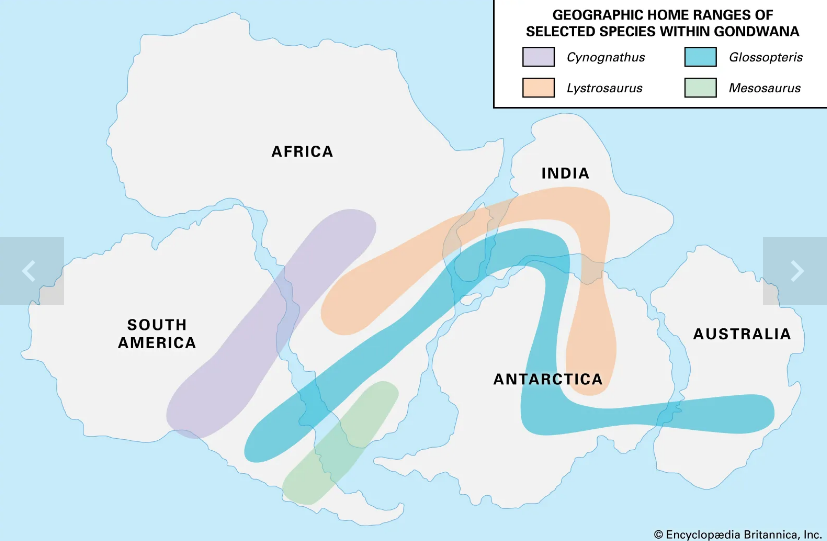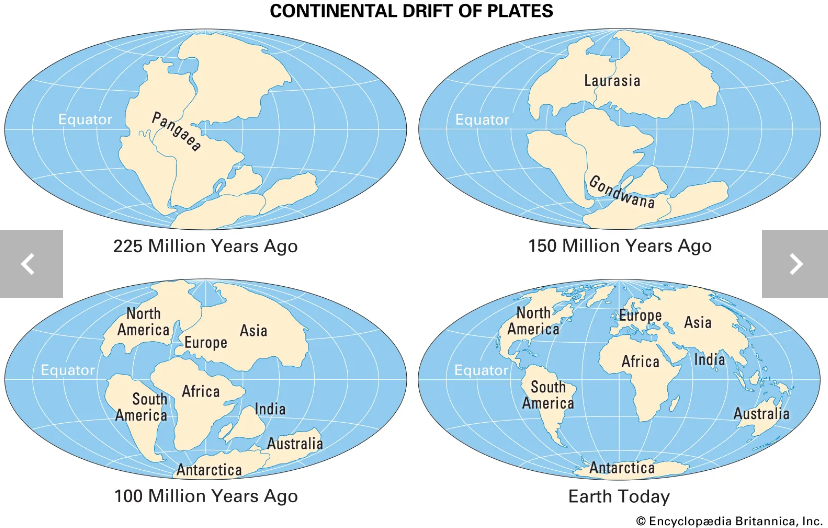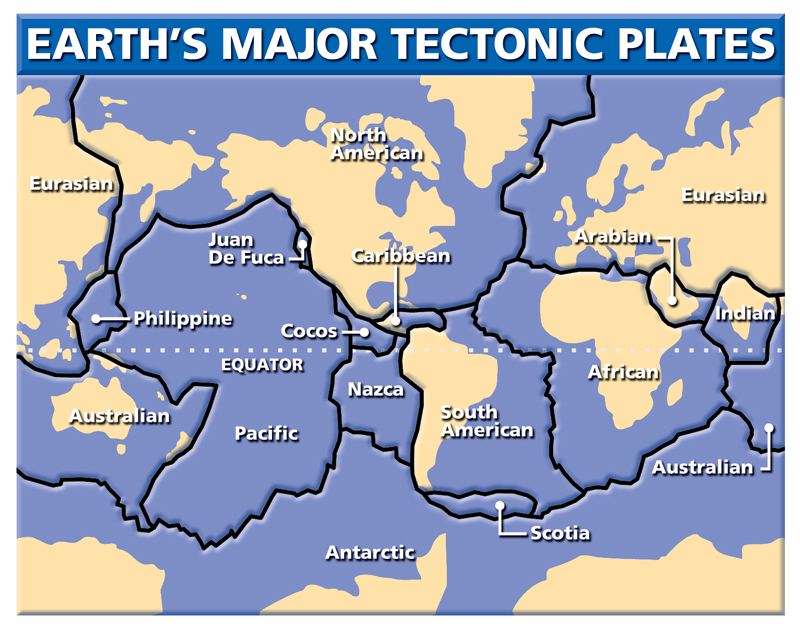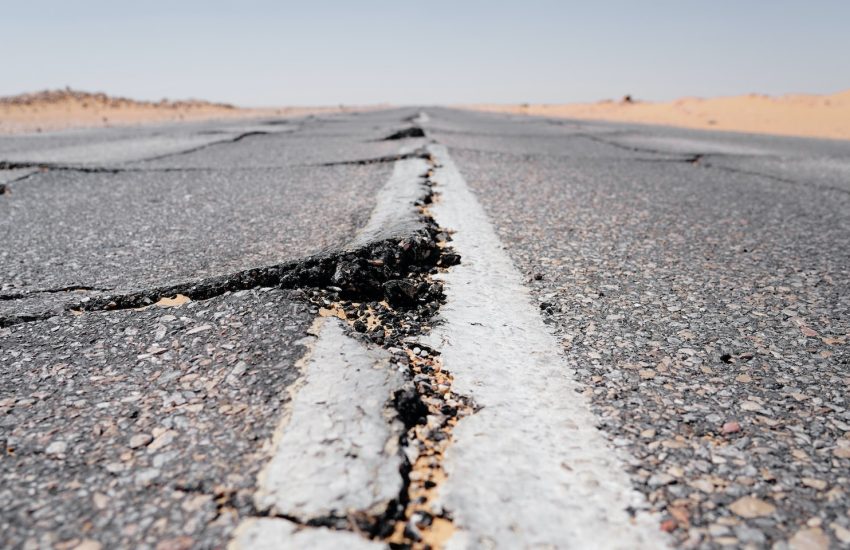In 1912, the German meteorologist Alfred Wegener developed the theory of continental drift. Wegener postulated the existence of a single supercontinent from about 350 million to 245 million years ago, during the late Paleozoic and early Mesozoic, and named it Pangea, meaning “the all-land.” Pangea was the product of continental drift caused in part by tectonic plate movement. He searched the geologic and paleontological literature for evidence supporting the continuity of geologic features across the Indian and Atlantic oceans during that time period, the Mesozoic, about 252 million to 66 million years ago. He presented the idea of continental drift and some of the supporting evidence in a lecture in 1912, followed by his major published work, The Origin of Continents and Oceans (1915).

Wegener based his theory on the geographic home ranges of certain prehistoric animals: the Cynognatus, the Glossoptaris, the Lystrosaurus, and the Mesosaurus. The conclusion from his observations was that the now separated continents must have been connected many millions of years ago. (See drawing above).
His ideas were first laughed at and rejected. But today we have solid evidence that the tectonic plates of the earth are indeed moving and with them the continents – a process that started about 2.5 billion years ago. Since about 1960, we can monitor continental drift by satellite.
Over a period of about 75 million years, the supercontinent of Pangea fell apart due to earth mantle convection and its parts drifted off in different directions. About 150 million years ago Pangea had split into the sub-continents Laurasia and Gondwana and 50 million years later, todays major continents had developed but were still much closer together than they are today. Pangea drifted apart at a speed of approx. 1 mm per year.

Today, we distinguish 17 major tectonic plates: Eurasian, Australian, Philippine, Juan De Fuca, Pacific, Cocos, Nazca, Antarctic, Caribbean, North American, South America, Scotia, Eurasian, Arabian, African, Australian, and Indian. Some of these plates carry major continents, which move as the plates move. Since the earth is a globe, the drifting continents move both toward and away from each other. Continents and tectonic plates move around at speeds between up to 10 centimeters (4 inches) per year.

The Pacific plate is moving to the Northwest at speeds between 3-4 inches per year. The current movements of the tectonic plates and the continents suggest that in about 250 million years in the future two major supercontinents will have formed: one called “Aurica” will form around the equator and another called “Amasia” will form around the North Pole.
Researchers found that the frequency with which continents have been colliding has been increasing over at least the last two billion years. They also found that the rate at which new supercontinents form has been increasing, and the length of time ocean basins last has been decreasing. In other words: the architecture of earth is changing faster.
Earth is basically a floating ball of slick magma with a thin shell of crust around the outside. The crust is broken into large parts, the so-called tectonic plates, and these plates continue to push into and crunch away at each other. In many places on earth they slide over resp. under each other. These horizontal movements can cause vertical movements: one plate pushes the other one up or down.
For example, the Alps in Europe are growing higher at a speed of about 785 mm every 1000 years. Almost one millimeter per year. This is partly due to the African plate pushing itself under the European plate lifting it up in the process. If this movement continues, the Mediterranean Sea will eventually disappear and the Alps may end up being higher than the Himalayan mountains.
Another example is the San Andreas Fault. Here, the pacific plate and the North American plate collide. The North American plate moves in a southeastward direction and the Pacific plate moves northwestward. They push and grind against each other with an annual slippage of about 1.3 – 1.5 inch. The Pacific plate is pushing itself (is “subducted”) under the North American plate, lifting the latter up. This happens because oceanic plates are usually heavier than continental plates. One effect is that the American West Coast is rising.
The collision of tectonic plates causes also an abundance of earthquakes and volcanic activity in particular, when more than two plates collide. In Japan, the US West Coast, and in the Mediterranean theater four plates push against each other. The Indian tectonic plate is the fastest. With a speed of almost 8 inches per year, the Indian plate ran into the plate that carries Europe and Asia starting 20 million years ago. The process continues.
The North American plate and the Eurasian plate are rotating, the North American plate counter-clockwise, the Eurasian plate clockwise. Like two interfacing sprocket wheels. The interaction between the two plates may contribute to the sinking motion of the bottom of the Atlantic, which in turn probably contributes to the slow but constant sinking of the American East Coast. And much of what we believe to be “rising seas” may actually be sinking lands.
Tectonic plate shift and continental drift are no longer a theory. They are a fact. There are end moraines of glaciers in the equatorial tropical regions of South America and Africa and there are large coal deposits in Antarctica. There must once have been glaciers where today there is tropical rain forest. And there must once have been tropical rain forest, where today there are 10 miles of ice. There is only one reasonable and rational explanation for these phenomena: tectonic plate shift, which moved these land masses into other climate zones.
Methane (CH4) is one of the so-called greenhouse gases that, unlike CO2, does indeed have a significant and unlimited effect on increasing the atmospheric temperature of our planet. According to conventional wisdom, methane is produced by the decomposition of organic matter – wetlands, termites, landfills, cow farts etc. In other words: methane is a biotic gas the occurrence of which is predicated on the existence of organic matter, i.e. life. So, finding methane on Mars would have justified the conclusion that there is or at least was life on Mars.
Since all methane was deemed to be biotic, the presence of methane in the atmospheres or soils of other planets has been interpreted as proof of life and it is one of the key beliefs of man-made global warming believers that we can control methane by controlling its biotic sources. (Dead cows don’t fart.)
But not so fast. Recently, it was discovered that methane can also be produced chemically in the lithosphere (in rock) of the earth or of other planets in the absence of organic material.
Although it has long been known that methane exists submerged in the seabed and is released from deep-sea vents, the gas’s source in this underwater environment has not been fully understood, until now.
The story was first published by Woods Hole Oceanographic Institution (WHOI) in the Proceedings of the National Academy of Sciences on August 19th, 2019.
It has long been known that ocean bottoms release significant quantities of methane but it was unknown where this methane came from. Now we know that abiotic methane can be created by naturally occurring chemical reactions that do not involve organic matter or living creatures.
“We were totally surprised to find this massive pool of abiotic methane in the oceanic crust and mantle.”
Frieder Klein, a marine geologist at WHOI and lead author of the study.
Jeffrey Seewald, a scientist of Marine Chemistry and Geochemistry at WHOI and one of the authors of the published paper, explains that the study points to methane-rich inclusions being common in olivine-bearing rock. Those rock formations may be the main source of abiotic (non-biological) methane on the planet.
The quantity of methane in olivine-bearing rock pockets is enormous, perhaps more than that in the entire Earth atmosphere prior to the industrial revolution.
To better understand the source of the methane in the ocean, Seewald and his fellow WHOI researchers collected and analyzed rock samples. They collected a total of 160 pieces of rock from ocean ridges, subduction zones, and ophiolites or uplifted sections of oceanic crust.
The samples were tested with spectroscopy and microscopy techniques. The tests showed that the rocks, often along with hydrogen, contained large pockets of methane.
The researchers say that these pockets of methane are produced as seawater moves through the deep oceanic crust. It then becomes trapped in hot olivine, a rock forming mineral and the primary component of Earth’s upper mantle.
The mineral cools as time passes, allowing the stored water to go through serpentinization, a chemical reaction that produces hydrogen and methane. The methane and hydrogen can remain sealed within the rock for eons after formation until the rock deteriorates or fractures.
Which brings us back to tectonic plate dynamics. When tectonic plates move and rub against each other, the olivine breaks and develops cracks through which the methane can now escape and bubble up though the ocean water into the atmosphere. The authors of the study, Frieder Klein, Niya G. Grozeva, and Jeffrey S. Seewald, are unable at this point to measure reliably how much abiotic methane may be trapped in the olivine of the ocean mantle. But they do estimate that it must be “a massive amount”.
These facts seem to lead do several obvious conclusions:
- There is probably more methane of abiotic origin on earth than of biotic origin.
- The presence of methane in the soil or atmosphere of other planets or moons no longer justifies the conclusion that there must be or must have been life on this planet or moon.
- Since we cannot control the chemical processes that produce the methane in the olivine rock of the ocean mantle, we can also not control how much abiotic methane develops inside these rock formations.
- Since abiotic methane is released from the olivine as the result of tectonic plate dynamics and since we cannot control them either, we cannot control how much of the abiotic methane is released from the rock into the atmosphere.
- Even if we could completely stop the production of biotic methane from organic sources, we would still be unable to reduce the release of abiotic methane from the oceanic lithosphere into the atmosphere.
Hm – maybe we are – again – barking up the wrong tree with our attempts to control biotic methane. If we have finally dried out all wetlands, killed all cows and sheep, eradicated all landfills, and perhaps reduced even mankind itself to a fraction (a program item of Klaus Schwab’s Great Reset), we might find out that it takes only one big methane belch from the oceans and we are back to square 1.
Should we perhaps try to understand our ecosystem and climate dynamics a bit better before we tinker with drastic remedial measures and end up with another “COVID control” situation – ineffective remedies that cause more damage than the disease?
